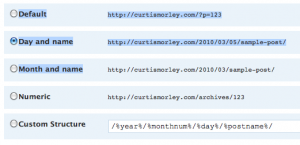- Determine Beforehand the 1-3 Keywords You Want Google to Find.
Before you type a single line, determine which keywords you will target with your post. In other words, what do you want people to type into Google to find your blog post. Once you have these keywords put them all over in your post in different variations. You will notice that throughout this post I will include the terms; “Google Food”, “Search Engine Indexing”, “Google to Index your Site”, “High Rankings in Google”, “SEO and Google Ranking”, etc… (Oh look I just added them again) - Put at Least One of the Three Keywords in the Title.
If you want Google to list you with a high search ranking for the word “Leadership”, an appropriate title would be, “Leadership for the Next Century.“ For Google to index your site, the way you want it indexed, you must have a title that contains at least one of these keywords. Because of the font size of the Header it will increase in importance according to Google’s algorithm. - Make Sure that WordPress (or whichever blogging software you use) is Setup to Create Each New Page URL the Same as the Title.
In WordPress (the most common blogging tool which this site is based off of) Go to Settings >> Permalinks >> Select >> and choose either “Day and Name” or “Month and Name”. The URL is critical to search engine indexing. If the link says www.myblog.com/leadership vs. www.myblog.com/?p=123 it will be Google Food. - Caption all Images with the Keywords Chosen.
If your term is “Leadership” then insert an image that portrays leadership and then give it a title and caption that has the word leadership in it. Notice the caption of the image above. The caption and title of this post reads nearly identical. - Match Your Categories, Tags, Excerpt and Metadata to Your Keywords.
Include several variations of the keyword terms in the tags, categories, and excerpts. For example – Leadership in Action, Corporate Leadership, Leadership Consulting, Leadership Solutions, Organizational Leadership, etc… This is an easy way to get high rankings in Google. - Keep to a Theme
Give your blog a theme and keep things organized within that theme. Don’t write about your dog one day and U.N. Diplomacy another day. Make sure that you are consistent in what you post. Google loves reading blogs that not only have appropriate keyword density on a page but keyword density across your whole site. - Link to and From at Least Three Other Sites
Do a Google search on the keyword that you are trying to target and start clicking on the most popular. Find a way to comment on each of the top sites and make sure to include a link back to your blog. Also, throw an update (with link) on Twitter. Within your blog link over to other sites (including within your own site and other domains you own or use) that will most likely link back to you. The more links you can get the higher your “popularity” and Google is like a teenager the way it cares about popularity. Another great site that has a lot of great info on SEO and Google ranking is my friend’s site called Nick’s Traffic Tricks
Thanks and Happy blogging.
Curtis J. Morley


